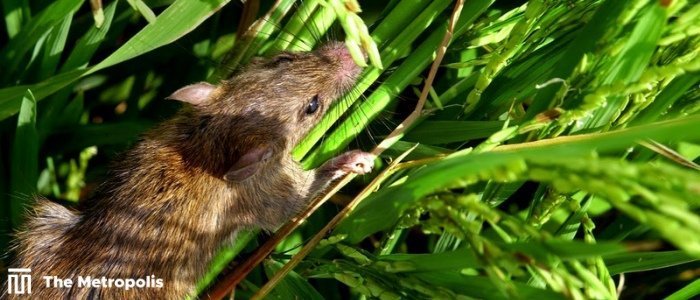Photo: Nature and Farming-
Rashidul Islam & Masum Hossain –
Food security is one of the most discussed topics these days. The global food production, supply, and distribution system have been adversely affected by the Covid-19 pandemic and the subsequent Russia-Ukraine war. Despite being one of the world’s fastest-growing countries in terms of food production, rodent infestation remains a threat to our country.
According to the data available from the Bangladesh Rice Research Institute (BRRI), every year in Bangladesh 7 lac metric tons of food grains worth at least 3 thousand crore takas are destroyed by rats alone, which could have fed at least 50 lac people in the country for at least a year.
Despite the bumper production of Aman paddy this year, the farmers have become fed up with the rodent infestation. All methods used by the government and the people to control rats are failing to get any benefit. A large part of the production is being swallowed by the little monsters called rats.
Mosaddek Hossain, Additional Director (Crop) of the Department of Agriculture Extension, Khulna said, “Rats and other harmful insects destroy about 8 percent of the year’s total rice production.” He also said, “Rats damage 7 percent of rice in the land. A further 1 percent is damaged in storage. However, we have undertaken a multifaceted program to control rats. Awareness campaigns and training have been organized to make the farmers aware, the benefits of which are available. Farmers’ awards have been arranged at the national and regional levels to encourage this work.”
SM Al-Amin, Deputy Assistant Agriculture Officer of Bogra’s Kahalu Upazila Agriculture Extension Department, told The Metropolis, “Rats can be killed with various techniques as needed. To kill the rats, various traps or holes must be set up. Applying glue to wooden boards, tin, and thick cardboard in the warehouse or at home and using it on rat routes gives good results. But the tempting food must be used. Rats are also easy to kill with poison bait. A single dose of poison kills rats within hours.”
He also said, “Also, rats can be killed by owls, foxes, mongooses, wild cats, snakes, monitor lizards, and cats. Through the increase of these rodent-eating animals, farmers’ crops will be saved from the clutches of rats.”
According to BRRI, some countries such as the United States, the United Kingdom, Israel, Jordan, Malaysia, and Hungary are using owls to control rats in crop fields. That is why they are encouraging the breeding and rearing activities of the owl at the farmer level along with preserving the ecosystem for the owl. Various research reports have shown that a pair of owls can eat up to 3000 to 5000 rats weighing 50-70 grams to raise 4 to 6 young owls in a breeding cycle of four months.
Muhammad Nazrul Islam, Additional Director of Bogura Agriculture Extension Department, told The Metropolis, “Rats cannot stay in places where there is light. Therefore, arable land should always be kept clean. Rat-killing techniques should be adopted. Rats damage wheat fields the most as light and air cannot easily pass there.”
He further said, “Farmers are always advised to control rats. Besides, awareness campaigns are being conducted in schools and colleges. With the combined efforts of all, it will be possible to kill rats. We are trying.”
Khulna Dumuria Upazila Agriculture Officer Insad Ibn Amin said, “Rats are now the main enemy of farmers in this area. Rats cause a lot of damage to crops. Especially the tender and ripe grains of rice are cut. Rats also cut tree trunks. To make the farmers aware, we are campaigning at home and field. But farmers are more aware now than in the past.”
Mizanur Rahman, a farmer of Sujanagar upazila in Pabna, said that various methods including aluminum phosphate (tablet) are used to kill rats in paddy fields and warehouses. Dropping a tablet into a rat hole kills the rats in that area of the field. Even if the torture of rats is reduced, rice cannot be saved to 100 percent. No matter what efforts are made, rats will damage crops.
Every year, since 1983, rat extermination campaigns have been conducted in the country. Additional Deputy Director (Grains) of Bogura Agricultural Extension Department Enamul Haque said, “Every year in July we start the rat extermination program. This activity lasts for a month. Instructions are given to Deputy Assistant Agriculture Officers in this regard. They kill the rats with the farmer at the field level. Teachers of various schools and colleges also participate in this program. Prizes are distributed at the end of the rat-killing month. Whoever kills the most rats is rewarded. In this competition, participants are asked to kill rats and collect the tails and submit them.”
Masud Rana Shanto, a farmer who received an award for killing rats, said, “The crops cannot be saved even after using various methods to control rats on the land. Rats are causing economic damage. We kill rats with poison. But it is difficult to eradicate them. Everyone should come forward in this regard.”
Salim ul Islam, another award-winning farmer of Dumuria, said, “There is a lot of rat infestation in the paddy fields of swamp and the fish enclosures. We use wheat bait to kill rats. However, it does not completely suppress rats. If all the farmers take part in rat extermination at the same time, good results will be obtained.”
According to BRRI, rat breeding is high during the Amon season due to the availability of safe shelter, adequate food and water, less rainfall, and favorable weather conditions at the end of the season. As a result, the number of rats increases compared to other seasons. Rats need to be killed before they start breeding. So, the best time for rat control during the Amon season is Bhadra to mid-Kartika. Because at this time the number of mice in the field is less. As there is not a lot of food in the field, rats easily eat poison bait at this time. If the rats can be killed before they damage the crop, their population will be reduced and the damage to the crop will be much less. At the time of rice planting and within 45-50 days after planting, rat control measures should be taken in the paddy field and surrounding areas.
Terokhada farmer Aslam Hossain said, “More rats are born than we kill. That is why elimination is not possible.” Mice are very clever and fast-breeding animals. According to agronomists, 1 pair of mice can produce about 3 thousand offspring in its lifetime.
Md. Faridul Hasan, Additional Director of the Department of Agriculture Extension, Khulna, said, “In the Khulna region, the arable land should always be kept clean in the perimeter fencing and land lanes. Rat-killing techniques should be adopted. Rats damage paddy and wheat fields the most.” He further said, “Farmers are always advised to control rats. Besides, workers and farmers are being made aware through training at the field level. The benefits of which have started to materialize. The rat extermination drive will continue.”




